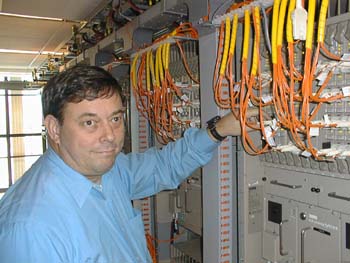![[Metroactive Features]](/features/gifs/feat468.gif)
[ Features Index | Metro | Metroactive Central | Archives ]
Hubba Hub
 In the heart of the second-busiest intersection in cyberspace, MAE West By Michael Learmonth AT MIDMORNING, the intersection of North Market and Post streets in the capital of Silicon Valley is incongruously short of bustle. The street is empty, except for a woman hustling a child by the hand and a man emerging with java from the otherwise-empty Boulangerie. That this is Main Street, San Jose, the biggest city in the most productive economy on the globe, is hidden beneath a sleepy street-level veneer. But just a few floors above the street, the information economy beats in the heart of a small room of wires and switches named for a 1930s screen goddess, Mae West. A robust icon of womanhood, MAE West is the second-busiest intersection in cyberspace. Ensconced in the gold-mirrored building at the corner of Market and Post, MAE West is a "network access point" that handles, by some estimates, as much as 40 percent of the nation's Internet traffic. Owned and operated by MCI Worldcom, the MAE (short for Metropolitan Area Ethernet) is one of the two largest network access points in the world. Slightly larger is MAE West's sister hub, MAE East, just outside Washington, D.C., in Reston, Va. On the first floor of the gold building--just outside the regional office of the IRS--a golden figure suggests Mae West's voluptuous allure. It is an overtly sexual brass statue of a woman lounging in the midst of a fountain, her C-cup womanhood casting reflections in the pool. In the front office of MCI Worldcom, the sign announces that company stock today is trading at $93 a share. Dan Lasater comes out to meet me. He is the caretaker of MAE West, her physician, her trainer and, today, her publicist. Before we can visit, we have to spend some time in the classroom, where Lasater can go over her proportions. Built in 1995 with a grant from the National Science Foundation, the MAE carries 1.9 gigabits per second, and thanks to the explosion of worldwide connections to the Internet, this number doubles every six months. Should Lasater kick the wrong plug walking around in the steel cage that houses MAE West, at least 1 million Internet sessions would drop--simultaneously. Keeping MAE West perky, even in the event of a power outage, is a generator in the basement and a room full of batteries so immense that the floor beneath them had to be reinforced to hold them up. But if something should happen to MAE West, however unlikely that may be, Lasater assures me the interruption on the Internet would be temporary while a web of millions of servers found its way around the problem. When the first MAE was built in Vienna, Va., there were only four Internet Service Providers (ISPs) in existence. Today there are more than 4,500. Lasater swipes his key card at the door and we go into the systems room. There is the ubiquitous whirring white noise of the place and aisle after aisle of black-doored cabinets. Those, it turns out, are not actually part of MAE West herself, but are leased to ISPs that want to have their nodes as close as possible to her. It turns out MAE West is imprisoned in a steel cage--not because Lasater thinks she might run away, but to protect her. Green lights dance above switches connected to a maze of orange cords. The room smells faintly of burning dust and static electricity. She's not very big, or very curvy, but it's clear Dan Lasater has gone sweet on her anyway. He opens the gate and allows me to take a celebrity photo of MAE West with her caretaker at her side. And even though he let me inside, he assures me that the steel gate is only the beginning of MAE West's security detail. "The best kind of security is the security you don't see," he says. "I'd tell you more, but then I'd have to kill you." Lasater and his staff are in the process of updating MAE West to give her a more '90s look. She's slimming down from her 1940s bombshell silhouette as Lasater and his staff convert her to svelte Asynchronous Transfer Mode (ATM) technology. Now the switches, which handle 3.2 billion bits a second, fill a space no bigger than a large closet. When the transfer is complete, MAE West will consist of three file-box-sized switches, each capable of handling 10 billion bits a second. Anyone can check out MAE West for free on the Internet (sorry, Mom, the filtering software won't catch it) at www.mae.net. [ San Jose | Metroactive Central | Archives ]
|
From the April 22-28, 1999 issue of Metro.
Copyright © Metro Publishing Inc. Maintained by Boulevards New Media.